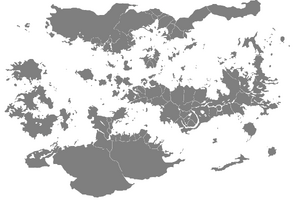
Venus Terraformed
There is a debate about whether or not Venus can be terraformed into a planet capable of hosting terrestrial life. There would have to be several major, costly & time-consuming climate changes:
- Reducing Venus' 850°F (773 K) surface temperature.
- Eliminating most of the planet's dense 9 MPa (~90 atm) carbon dioxide atmosphere, via removal or conversion to some other form.
- reducing the Venusian acid rains.
These goals are closely related, since Venus' extreme temperature is due to the greenhouse effect caused by its dense atmosphere.
Decreasing Temperature
The construction of a solar shade is impractical and thus will be overlooked in this article
Temperatures will have to be dramatically reduced by thinning the atmosphere, reducing the thermal insolation ( Green House effect ) it creates. Next we would increase the rate that Venus rotates, shortening its day until it reaches a length closer to Earth's 24-hour day. This would stabilize temperatures on Venus's Eastern and Western Hemispheres. Once a Water-Ocean has been stabilized, Nitrogen can be added to the atmosphere, dissolving approximately 2 bars of atmosphere into the new ocean
Eliminating Dense Carbon Dioxide Atmosphere
The Microbiological Approach
Originally proposed by Carl Sagan and other physicists in the 1960s and 70s, the idea of using genetically modified microorganisms was debated, but subsequently abandoned due to discoveries regarding the Venusian atmosphere. However, since the 1970s, major discoveries in microbiology could allow us to develop a certain strain of microbes adapted for survival in the atmosphere of Venus. These microbes could remove a significant amount of the carbon dioxide, reducing the greenhouse effect, and the subsequent lowered temperature may indeed render the surface of Venus habitable.
Requirements of the Microbes:
Currently, technology such as In Vitro and In Vivo gene cloning, Recombinant DNA Technology and selective breeding could be used to make specific microbe strains, whether bacteria or fungal, that could survive and thrive in the Venusian atmosphere. The microbes would need the following traits:
- Be able to photosynthesise (to remove CO2): strains of "purple" bacteria such as Rhodospirillaceae, a family of Proteobacteria that can photosynthesise would be able to remove Carbon Dioxide according to the equation: 6CO2 + 6H2O C6H12O6 + 6O2 ; These bacteria are anaerobic in nature, and could serve as the biological base from which more traits can be added. Of course, green bacteria or cynaobacteria, or certain fungus species could prove more effective.
- Temperature and acid resistance: some bacteria found on Earth have traits enabling them to survive in harsh environments. As of April 2018, the University of California, Berkeley, have discovered microbes that have enzymes adapted for temperatures as high as 109 degrees Celsius (228 degrees Fahrenheit), significantly above the 100℃ (212℉) boiling point of water[1]. If these bacteria were to be selectively bred to increase their heat resistance, they could potentially survive the high temperatures in Venus' atmosphere. Bacteria have also been found to contain enzymes that can reduce the damage caused by acidic conditions[2] . This would allow the microbes to survive the acid rain caused by the sulfuric acid in the atmosphere. Of course, the genes that code for the proteins that make up the enzymes necessary can be transplanted into a specific species by using the Polymerase Chain Reaction (PCR), and Reverse Transcription, as well as using restriction Endonucleases and vectors such as bacterial plasmids to transfer new DNA into the new host cell, from which a new bacterial culture could be produced[3]. So called "suicide genes" could also be added to cause the bacteria to die once the concentration of carbon dioxide reached low enough levels.
- Ionising radiation resistance: To enable bacteria to survive the harsh environment of the ionising radiation, genes would need to be added to the selected strain to prevent early death.
- Able to reproduce rapidly: The fastest reproducing bacteria currently known is Pseudomonas natriegens, which has a generation time of 9 minutes and 48 seconds, so will go from 1 to over 100 cells (under the proper conditions) in around 70 minutes. The genes responsible could be transfered using the aforementioned techniques to produce a bacterial strain that could remove a significant quantity of carbon dioxide in a matter of decades.
- Able to be stored effectively and survive the transit from Earth to Venus: Bacteria have been found in some of the coldest and most hostile environments on Earth, and so the launch and transit vehicle/probe could be engineered to hold the bacteria in a stable state before being released into the atmosphere of Venus.
Of course, these methods are complex and could fail entirely; but the fact remains that these technologies exist now, and could be utilised in the coming decades to begin to terraform Venus into a potentially habitable planet.
Floating Cities

a 2D map layout of what Venus's surface might look like terraformed. Unlike Earth, there is only one main continent, as well as several smaller islands surrounding it.
Geoffrey A. Landis proposes colonizing the cloud-tops of Venus. Initially, the image of floating cities may seem fanciful, but Landis' proposal points out that a Terran breathable air mixture (21:79 oxygen-nitrogen) is a lifting gas in the Venusian atmosphere, with half the lifting power helium has on Earth. In effect, a gasbag full of human-breathable air would sustain itself and extra weight (such as a colony) in midair. At an altitude of 50 km above Venusian surface, the environment is the most Earth-like in the solar system - a pressure of approximately 1 bar and temperatures in the 0°C-50°C range. Because there is not a significant pressure difference between the inside and the outside of the breathable-air balloon, any rips or tears would cause gases to diffuse at normal atmospheric mixing rates, giving time to repair any such damages. In addition, humans would not require pressurized suits when outside, merely air to breathe and a protection from the acidic rain. Without a pressurized suit, low pressure, like on Mars, would cause a human's blood to boil.

Another hypothetical political map of Venus.
Such colonies could be constructed at any rate desired, allowing a dynamic approach instead of needing any 'fell swoop' solutions. They could be used to gradually transform the Venusian atmosphere, with their impact directly related to the number of colonies in the atmosphere. As the constructed colonies increased, more solar panels could be used to absorb insulation and thus cool Venus; they could also be used to grow plant matter that would reduce the amount of carbon dioxide in the air. In the beginning, any impact on Venus would be insignificant. As the number of colonies grew, they could transform Venus more rapidly.
Introducing Hydrogen
Bombarding Venus with hydrogen, possibly from some outer solar system source, and reacting with carbon dioxide, could produce elemental carbon (graphite) and water by the Bosch reaction. It would take about 4×10^19 kg of hydrogen to convert the whole Venusian atmosphere. (Loss of hydrogen due to the solar wind is unlikely to be significant on the timescale of terraforming.) Due to the relatively flat Venusian surface, this water would cover about 80% of the surface compared to 70% for Earth, even though it would amount to only roughly 10% of the water found on Earth.
The remaining atmosphere, at around 3 bars (about three times that of Earth), will mainly be composed of nitrogen, some of which will dissolve into the new oceans of water, reducing atmospheric pressure further, in accordance with Henry's law.
In the long term introducing hydrogen into Venus will be necessary because hydrogen is one of the main elements required for terrestrial life to exist because of it's use in photosynthesis and organic molecules. Could be obtain from trans- Neptunian objects which are directed on a collision course with it. Alternatively moons such as Hyperion provide potential. There might also be hydrogen in the core or mantle of Venus under the assumption that there likely is also in Earth which is similar in structure.
Transformation Into Carbonates
Bombardment of Venus with refined magnesium and calcium metal could sequester carbon dioxide in the form of calcium and magnesium carbonates. About 8×10^20 kg of calcium or 5×10^20 kg of magnesium would be required, which would entail a great deal of mining and mineral refining. 8×10^20 kg is a few times the mass of the asteroid 4 Vesta (more than 300 miles in diameter).
Modelling by Mark Bullock of Venus' atmospheric evolution suggests that existing surface minerals, particularly calcium and magnesium oxides, could serve as a sink of carbon dioxide and sulphur dioxide. If these could be exposed to the atmosphere then the planet would cool and its atmospheric pressure decline somewhat. One of the possible end states modelled by Bullock was a 43 bar atmosphere and 400 K surface temperature.
Rotation
Venus rotates once every 243 days – by far the slowest rotation period of any of the major planets. A Venusian sidereal day thus lasts more than a Venusian year (243 versus 224.7 Earth days). However, the length of a solar day on Venus is significantly shorter than the sidereal day; to an observer on the surface of Venus the time from one sunrise to the next would be 116.75 days. Nevertheless, Venus's extremely slow rotation rate would result in extremely long days and nights, which could prove difficult for most known Earth species of plants and animals to adapt to. The slow rotation also likely accounts for the lack of a significant magnetic field
Speeding up rotation
It has been speculated that it would be possible to speed up the rotation and tilt the axis more by running the planet mercury (or a galilean moon) in a close flyby and locking it in as a moon. Using Oort Cloud bodies for hydrogen seeding, with careful planning, they could also be used in close flyby to speed rotation, as suggested by recent scientific research. *
More recent research has however shown that the current slow rotation rate of Venus is not detrimental to the planet's capability to support an Earth-like climate. Rather, the slow rotation rate enables the formation of thick cloud layers on the side of the planet facing the sun, which raises planetary albedo and acts to cool the global temperature to Earth-like levels, despite the greater proximity to the sun. According to calculations, maximum temperatures would be just around 35 °C, given an Earth-like atmosphere. Speeding up the rotation rate would therefore be both impractical and detrimental to the terraforming effort. A terraformed Venus with the current slow rotation but a more Earth-like atmosphere would result in a global climate similar to warmer versions of Alaska or Siberia with "day" and "night" periods each about 58 days long. The "day" would resemble a short summer with warm humid climate, a heavy overcast sky and ample rainfall. The "night" would resemble a short winter with quite cold temperature and snowfall. There might be periods with more temperate climate and clear weather at sunrise and sunset.
Polar Orbiting Mirror
In 1991, Paul Birch proposed that instead of trying to speed up the rotation of Venus, that if a slatted system of mirrors were placed near the Lagrangian L1 point, between Venus and the Sun, they could be used to reflect the intense sunlight, heading towards Venus, away from the planet. A soletta mirror could then, if placed in a 24-hour polar orbit, tilted at an angle to focus sunlight striking it onto Venus, be used to produce a 24-hour light cycle over the whole surface of Venus.
See Also
External links
- Caeliforming Venus
- Hot springs microbe yields record-breaking, heat-tolerant enzyme[1]
- Surviving the Acid Test: Responses of Gram-Positive Bacteria to Low pH[2]
- Use of Plasmid Vectors[3]
See also: Venus Simulation